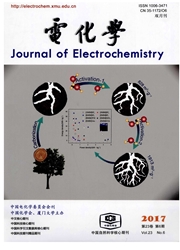

 中文摘要:
中文摘要:
将金属钴离子引入磷酸铝分子筛APO-5制得CoAPO-5分子筛,再把N,N-双水杨醛缩乙二胺(SALEN)希夫碱通过扩散进入CoAPO-5分子筛孔道并与其中的钴离子配位,形成了CoSALEN配合物,构成CoSALEN/APO-5复合材料.应用物理吸附法,以聚苯乙烯(PS)作粘结剂,将CoSALEN/APO-5涂敷在玻碳电极表面制成修饰电极PS/CoSALEN/APO-5/GCE.循环伏安法(CV)、计时电流法(CA)研究了该修饰电极在不同pH电解质溶液中的电化学行为以及对分子氧的催化还原作用.结果表明,制备的修饰电极能有效地催化分子氧的四电子还原,即氧气被电催化还原为水,据此提出可能的氧还原机理.
 英文摘要:
英文摘要:
CoAPO-5 molecular sieve was hydrothermally synthesized. The Cobalt ions in CoAPO-5 were coordinated with the SALEN ligend diffusing into the channels of the molecular sieve to form CoSALEN complexes. The electrochemical behaviors and electrocatalysis for dioxygen reduction of the CoSALEN complex immobilized in APO-5 modified glassy carbon electrodes ( GCEs) have been investigated by cyclic voltammetry( CV) and chronoamperometry ( CA) in differrent pH aqueous solutions. The results showed that the PS/CoSALEN/APO-5 /GC modified electrode is of the high electrocatalytic activity towards dioxygen reduction in pH 6. 86 buffer solution with a reduced overpotential of 447 mV lower than bare GC electrode. The electroreduction of O2 at the modified GCEs is irreversibly diffusion-controlled with four electrons per O2 molecule. The catalytic mechanism of dioxygen reduction at the PS/CoSALEN/APO-5 /GCE is suggested according to the results from CV and potential step chronoamperometry.
 同期刊论文项目
同期刊论文项目
 同项目期刊论文
同项目期刊论文
 期刊信息
期刊信息
